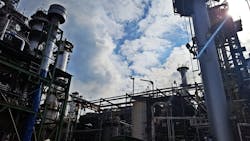Refining market analysts suggest high prices won’t easily go away
Amid frustrations over diesel and gasoline prices, a refiners’ association Apr. 4 held a news briefing to talk about the crude supply problems, recovering product demand, and domestic infrastructure limits that are supporting the high prices.
Susan Grissom, chief industry analyst at the American Fuel & Petrochemical Manufacturers, and John Auers, executive vice-president of consulting company Turner Mason & Co., laid out the explanations and warned that a rebalancing of the crude and product markets will not necessarily be swift.
Crude oil currently accounts for about 60% of the cost of oil products, Grissom said. The invasion of Ukraine by Russia has triggered a US ban of Russian oil imports, and while that is a contributing factor to market problems, US refiners will cope, she and Auers said.
American refiners already were well on their way to cutting Russian oil use before the sanctions, as shown by the sharp successive import reductions during December and January, Auers noted.
“Replacing Venezuelan heavy crude was a much more challenging task,” Auers said, referring to Trump administration trade sanctions in 2019.
The Russian imports in 2021 especially included unfinished feedstocks, notably vacuum gasoil and residual oil, and a few refiners were running the bulk of them, he said.
Demand up, capacity down
Grissom stressed the market gyrations are caused by the pandemic and, at the same time, reductions in refining capacity.
Recovery from the pandemic by consumers has occurred faster than crude oil production by US oil companies, she said, and that has helped boost prices for both crude oil and refined products.
At the same time, global refining capacity shrank by about 3 million b/d, of which 1 million b/d was in the US, making it harder for refiners to catch up to demand, she said. Six US refineries were either shuttered completely or have been transitioning to other operations, such as revamping equipment and feedstocks to make biodiesel.
Russian supplies especially were going to the US east and west coasts, where infrastructure constraints—pipeline and rail limitations—make it harder for refiners to obtain domestic feedstocks. In addition, the Colonial and Plantation pipelines, the primary arteries feeding refined products to the East Coast from the Gulf Coast, are full, Auers said.
A global shortfall of distillate stocks has been making diesel prices especially painful for truckers, while US gasoline stocks far better off, near the top of their 5-year range.
Asked how long diesel prices would remain so high, Auers said he did not anticipate a quick and easy solution. High prices will incentivize production and discourage consumption, he noted, then added his hope that restraint of consumption will not become serious demand destruction accompanied by recession.
The House Energy and Commerce Committee will hold a hearing Apr. 6 on oil prices. The title of the hearing suggests an unfriendly reception awaits oil executives: “Gouged at the Gas Station: Big Oil and America’s Pain at the Pump.”


